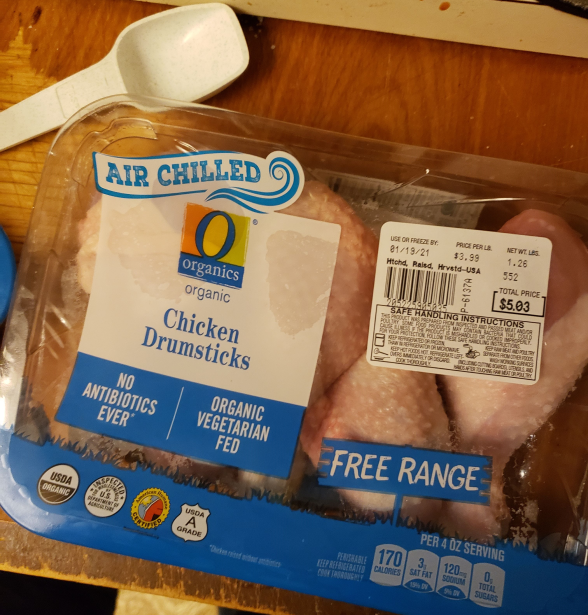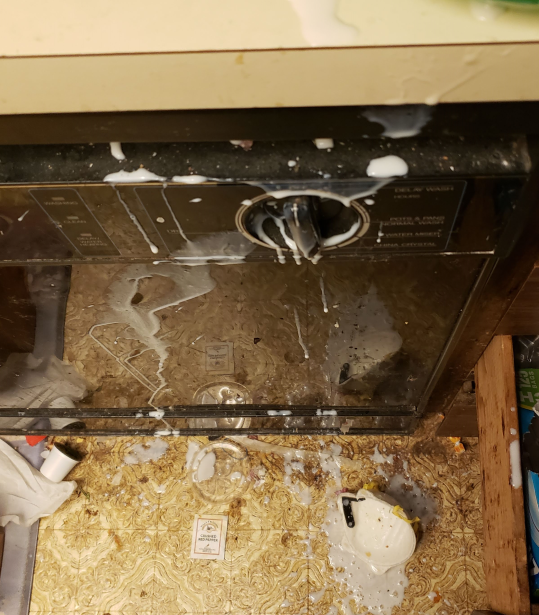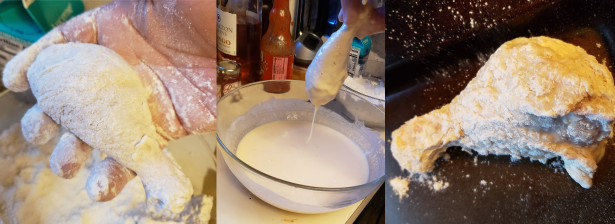KC 254 – The Meal That Never Was, part 1.

Why hello there, and welcome to Kitchen Catastrophe. I’m Jon O’Guin, and if you’re expecting an alliterative bit of silliness to open the post, as is our norm, I’m afraid you won’t find it here today. Today I intend to write something more solemn and serious. And if you’ve no appetite for it, you can follow this link to get today’s recipes, and come back…well, Thursday might be a little on the sharper side as well, but certainly by next week we will be back to form. For those who wish to stick with us, let’s dig into the Meal That Never Was, and the unfulfilled burden it represents.
A King And A Scholar
“If you spent all your money on a new house, and don’t have enough for a proper dinner, I’ll tell everybody”, a 39-year old preacher said to a friend. He’d had a similar dinner before, where “the ham was cold, and the Kool-aid hot”, and he didn’t want to repeat the experience. That man was Martin Luther King Jr. And those jokes were among the last things he said, spoken to his friend Samuel Kyles, before he went to Kyles’ house for dinner on April 4th, 1968. He barely made it out the door.
39 years old. As many have noted, he would potentially have turned 92 this weekend.
The dinner was meant to be an assortment of some of the Reverend’s favorite foods, for MLK Jr was known as a man of appetite and drive. He often ate 2 dinners a night, in order to better speak to different groups, because so many people invited him to dinner, and he wanted to join them and speak with them in a communal setting. Who wouldn’t want to have dinner with Reverend King?
It is fascinating, in a way, then, that the menu of that fateful evening, without the context of King’s approval, SCREAMS to the modern ear of a poorly-thought-out stereotypical attempt to reach out to the black community, which is why several restaurants have gotten into hot water for attempting to present it without context. The dinner was Fried Chicken, Collard Greens*, Black-Eyed Peas*, Ham, Sweet Potatoes, and a Sweet Potato Pie for dessert. (*- there is some dispute on the Collard greens and Black-Eyed Peas. Or, rather, it’s understood that two different recipes of greens were cooked, and there’s some debate whether they cooked Black-eyed Peas or Crowder peas,)
The two are very similar looking, so it’s easy to understand.
And that’s the difficulty, sometimes, with history. Reality can seem too shallow to be true. Stereotypes can be rooted in a place of reality. Of course, it’s one thing to smugly nod and say ‘see, it’s okay, he really did like Fried Chicken.’ It’s another to learn WHY Fried Chicken is so closely associated with Black cooks in America. Because the answer to that is slavery. Slaves were allowed to raise and cook birds to sell so they could one day afford to buy themselves back from their owners. Watermelon is associated with them because it is a food of the impoverished: watermelon is easy to grow, cheap, and you can label those eating it as ‘messy’ and ‘childish’. Indeed, the same attacks racist whites made against black farmers and freedmen eating and growing watermelon are echoes of attacks the British made against Arabs and Italians.
You may have long grown tired of the admonition that “food is political”, or that EVERYTHING is political. And there is a value in being skeptical of that stance. As Sigmund Freud probably never said, “Sometimes a cigar is just a cigar”. But one of the things I have worked for over the course of this show is to bring you an understanding of the origins of food. Their history and import. I do this because, yes, I do think that it makes it a little more fun to cook a dish knowing its history, and because defining a thing, and pinning it down, make it less scary. (Cheese Soufflé is less scary, to me at least, when you know that soufflé just means “puffed”.) But you may have noticed, here and there, the looming, inescapable presence of politics. Why does Hawaii love Spam? Because the US Army arrested a third of their fishermen for being part Japanese during World War 2. Many foods are invented during wars (Spanish Tortilla, Mayonnaise, Cassoulet, Spaghetti Napolitan), and many more are invented as people move around the world due to various policies. Politics is part of the DNA of most dishes.
Sometimes more blatantly than others.
And that’s often a good thing. Like, Hamburgers exists because of German sailors wanted food in American ports. Even literal white supremacists like tacos, and sushi. Food is also community. Trying new foods helps you, in a very small way, understand a people better. Thus today’s recipes, because while in the past I’ve often blown over Martin Luther King Jr Day, with the events of the past year, that felt inappropriate. It should surprise no one that I believe Black Lives Matter, and support that movement. As a previous Pre-law major, I support the goals of ‘Defund the Police’. (which, I’m sure if that upsets you, you’ve already stopped reading, but I do want to re-iterate: “defunding the police” has almost always meant “taking money from the police, and putting it into other social services in order to prevent crime before it occurs, thus reducing the NEED for police”. It’s also often connected with de-escalating or de-militarizing the police, which is a complicated topic we don’t have time to cover in the post, but I’d be happy to discuss respectfully in the comments.) And I wanted to approach this meal in the spirit of facing these issues: in taking this one step at a time, as it were. Starting where you’re comfortable, and pushing yourself to do more. As such, we’re not making the entirety of the meal today. I intend to save that for future year’s posts. Today, we’re tackling probably the two most accessible parts of the meal, the Fried Chicken and the Sweet Potato Pie.
A Metaphor and a Messy Night
Both recipes start the night before. Pies have to chill, and chicken needs to brine. You’ve got to lay the groundwork for your success. The first step is to just boil sweet potatoes for about 45-55 minutes.
I’m only going to use half of these for this meal. The other two are for various culinary experiments.
While that’s going, it’s time to work on the chicken. My recipe comes from Saimin Nosrat, because, while she is not African-American, she is a woman of color, which I felt was an important voice to highlight for the occasion: the fight for Black Rights helped the fight for feminism, and other marginalized voices. And her recipe is fairly direct and easy to follow. It’s a simple first step, taken in good faith. Similarly, I ended up using some fairly fancy drumsticks, rather than breaking a chicken down, because…well, because I knew that no one in my family really eats fried chicken breast, so I figured drumsticks would be better. I even called Nate, from the store, to check what he thought would work best…and then it turned out that my mother doesn’t like fried drumsticks, preferring thighs or wings. Even when putting in your best effort, sometimes what you do is going to alienate people. That shouldn’t stop you from trying, it should just inform you on how to do better next time.
It’s interesting how raising chickens has not really impacted my desire to eat chicken.
The chicken is then supposed to be salted, with a certain amount of salt, and the recipe takes the ever-important moment to specify how much salt that is DEPENDING ON THE SALT. This is something I don’t touch on a lot with my recipes, but the type of salt you use in your cooking can have huge effects on how your food turns out, and for a very easy explanation as to why, look at this picture.
High res vs low res?
The salt on the left is Morton’s Iodized Table Salt. The salt on the right is Morton Coarse Kosher Salt. You can see the different in grain sizes, and that’s going to affect how many grains of salt you can fit in a measurement, and also the amount of airspace left in the measurement. 2 tbsp of the one on the right is going to be roughly as much salt as 4 tsps of the one on the left. This might be a reason that, when following recipes, you find that the seasoning is off: all it takes is you and them using different types of salt. This kind of confusion is common in a lot of cooking, and in a lot of conversations about politics: people talking past each other because they think they’re using the word with the same meaning.
Anyway, mix your salt with some buttermilk for the chicken brine, get it into a gallon Ziploc, add the chicken, and then immediately spill some of it down the front of your dishwasher.
Luckily, it mostly spilled into a reusable facemask, a sentence that is far more common this last year than before.
Things are going to get messy sometimes. That’s to be expected. On a similar note, at this point I straight up left the house, because I forgot to pick up a pie crust while buying the sweet potatoes, and I did not have time to make one by hand that night. I came back, peeled the potatoes, and made the pie filling.
It’s a riot of ingredients, in fairly dramatic colors. Orange sweet potato, dark brown sugar, eggs, cream, some butter, and a mix of spices, several of which should be quite familiar: nutmeg, cinnamon, allspice or clove. Someone I read called Sweet Potato Pie “pumpkin pie with more texture”, and it kind of shows. I also used about an 1/8th of a teaspoon of berbere seasoning, an Ethiopian spice mix that’s pretty similar to ras al hanout, but the basic idea is you want just a TOUCH of spice to help cut some of the richness, so if you’ve only got like, cayenne or chili powder that’d work. I specifically used berbere because one of the first places I heard this meal ever mentioned or discussed was Marcus Samuelsson in some articles and books, and he often uses berbere with Sweet Potatoes. So I thought it a fun, subtle tribute to the man. (It was also undetectable in the finished pie, so maybe it could be a little higher, but we’ll see)
Another thing I probably should be much better at, given the 5 years of work: food photography. THIS one is pretty good, but some of the others…ugh.
Mix together, pour into a pie crust, bake, and let cool. Once it’s popped in the fridge, you’re done for the night. Pack it in and get ready to start again tomorrow.
A New Day Dawns
The next day, it’s time to fry the chicken. And let me give you some advice that I screwed up: When you take your chicken out, pat it dry. Get the buttermilk off of it, or at least mostly off of it. Otherwise, you’re going to get what I got, which is “balloon crust”: the crust is going to turn out perfectly fine, but that inner layer of buttermilk is going to steam while frying, pushing the crust off of the chicken, creating an air pocket around the meat.
The first thing you’re going to want to do is get your oil to temp. About a quart and a half of oil, maybe 2 quarts, in a large pot (the big thing is you want at least an inch and a half of oil covering the bottom of the pot, so how much you need will depend on the pot. I used a moderately big guy, so 6 cups did the trick.
Next, it’s time to make the buttermilk crust batter, which is going to consist of buttermilk, two eggs, and some hot sauce. You can use whatever thin hot-sauce you like: Tabasco, Cholula, Valentina’s, Crystal…I went with Frank’s Red Hot. You’re not going to get almost ANY of the flavor, it’s mostly, again, to help cut the richness a little.
You can leave the hot sauce out, if it’s too far for you. I urge you to try it eventually, but it’s okay to leave it out the first time.
You’ll also want some seasoned flour, just seasoned with two pinches of salt. The process here is a variant of what I call “the double-dredge”: you’re going to take your chicken, and cover it in the seasoned flour, shaking off the excess. Then you’re going to dip it into the buttermilk, coating, and allowing the excess to drip off. Then back in the flour, another coat and shake, before it’s totally ready to fry.
You’ll get your hands gunky, but as long as you try to keep one in the dry side, and one in the wet, you’ll get through.
Now, I ended up having 10 drumsticks, so I fried in 3 batches: 4 pieces, then 3, and then the last 3. Each batch is going to fry for about 12 minutes, and should be turned a couple times to ensure both sides are browning. And as with so many recipes, it’s so much easier if you’ve got help: having one person frying while the other batters ensures the crust doesn’t seep through with the excess buttermilk waiting, and it lets each person keep their full attention on the task. But if you have to go it alone, you can, it just might feel a little overwhelming. Hell, if you’re new to it, it’ll probably feel a little overwhelming anyway, but I assure you, you can do this.
See? Even I could do it.
And once it’s fried, you want to let it drain for a couple minutes on a wire rack over a paper-towel lined baking sheet…and then it’s ready to serve! As I said, we had the “balloon crust” problem, which was a small issue, but everyone agreed that the crust was tasty, and the chicken pretty good. My mother felt it was a little too salty, and she fastidiously tore the drumstick apart with a fork, because she has a long-standing suspicion of fried chicken after a KFC gave my brother a couple undercooked pieces. That’s going to happen: different people are going to have hang-ups that you’re going to have to work around or persevere through. Even with her suspicion, and distaste for drumsticks, she was willing to come back for a second piece. Nate stated that I had turned out better chicken than he had anticipated: he knew what I made was going to be edible, but he’d go so far as to call this “pretty good”, rating it about a 6 or 7.
Then we tried the Sweet Potato Pie. And that adage from earlier came back: it DID taste like pumpkin pie with a little extra texture (sweet potato fibers don’t break down as easily, leaving TINY little threads of potato fiber). It too was lauded as “very good”, with Nathan noting that too often pumpkin pie can get a little cloying, but this was very nice in balancing the sweetness.
My pie had a bunch of little cracks in the surface, I assume because my butter wasn’t fully softened, and left little streaks in the batter.
Because when you put in the work, even on the simple version of something, you CAN make progress, and improve things. Next year…I don’t know what I’ll do. Maybe I’ll start with a whole chicken and break it down, maybe I’ll make the pie crust, maybe I’ll just stick with these two recipes and add in the peas, greens, and ham before I start putting more effort into the recipes that are already proven to work. Do I bring in more stuff that needs to be addressed, or refine what I have first? It’s a tricky question. But the point is that I’ll be trying to do more, and that’s the goal: do more, and do it well.
You’ve got to dream big, and make it so. That’s the mentality that we’re honoring today: doing more for each other, working to make things better, and improving. I’d like to ask each of you to try that, so next year, we can feel better as we work on the next steps.
THURSDAY: JON DISCUSSES THE FIRST AMERICAN CHEF TRAINED IN FRANCE. IT IS…REMARKABLY NOT FUN. BUT IT IS IMPORTANT. JOIN US IF YOU CAN.
MONDAY: JON MAKES VEGGIE TACOS. WHICH SHOULD HONESTLY BE PRETTY FUN, SINCE THEY DO THE WHOLE DOUBLE SHELL THING, AND I EXPECT HE’LL SCREW IT UP AT LEAST TWICE.
Here's the
Recipes
“Classic” Buttermilk Brined Fried Chicken
(from Salt, Fat, Acid, Heat by Saimin Nosrat)
Makes 3 pounds of chicken
Ingredients
Chicken and Brine
3 pounds chicken, whether thighs, drumsticks, or broken down whole bird
Salt
2 cups Buttermilk
Batter
2 large eggs
2 cups buttermilk
1 tablespoon hot sauce
3 cups all-purpose flour
6 to 8 cups grapeseed, peanut, or canola oil for frying
Preparation
Mix together the salt and buttermilk in a gallon bag or other storage vessel. Add the chicken, tossing and turning to coat. Marinate 8 hours to overnight in the refrigerator, turning occasionally, if you have time.
Whisk together the eggs, buttermilk, and hot sauce in a large bowl. Set aside. Whisk the flour and 2 generous pinches of salt together in another bowl. Set aside.
Place a wide, deep pan over medium heat. Add oil to a depth of 1 1 / 2 inches, and heat to 360°F.
Remove the chicken from the fridge, dump out excess brine, and wipe/pat chicken dry. Begin dredging the chicken, one or two pieces at a time. First, dredge in flour and shake off the excess, then dip into buttermilk, letting the excess drip back into the bowl, then return to the flour mixture and dredge a final time. Shake off the excess and place on a baking sheet.
Fry chicken in two or three rounds, letting the temperature of the oil drop to and hover around 325°F while the chicken cooks. Use metal tongs to turn the chicken occasionally, until skin is a deep golden brown, about 12 minutes (closer to 16 minutes for large pieces, and 9 minutes for small pieces). If you are unsure that the meat is cooked through, poke through the crust with a paring knife and peek at the meat. It should be cooked all the way down to the bone, and any juice the meat gives off should run clear. If the meat is still raw or the juice has the slightest hint of pink, return the chicken to the oil and continue cooking until it’s done. (If you’re worried about this much knifework on still-hot chicken, you can also use an instant read thermometer, aiming for the 175 F range: it’s technically done at 165, but your reading can be thrown off a little by the hot oil.
Let cool on a wire rack set over a baking sheet.
Sweet Potato Pie
Makes one 9” pie
Ingredients
1 pound sweet potatoes
Water
Filling
1 packed cup brown sugar
2 large eggs
½ cup salted butter, room temp
½ cup heavy cream
2 tbsp all-purpose flour
1 tsp vanilla extract
1 tsp ground cinnamon
½ tsp nutmeg
¼ tsp allspice
¼ tsp berbere or ras al hanout (if unavailable, use 1/8th tsp cayenne or other sharp chili powder)
Crust
1 9” pie crust
Preparation
Boil the sweet potatoes for 45-55 minutes, until a knife meets no resistance when inserted. Preheat oven to 350 degrees.
Drain, and place under cold running water. Allow to sit for a minute or two, until cool enough to handle. Peel, and tear into chunks.
Place in a large stand mixer with a paddle attachment, and beat for 1-2 minutes, until smooth. Add all ingredient fillings, and beat together until smooth and combined. Pour into prepared pie crust.
Place in the over, and bake for around 60 minutes, until a toothpick inserted in the center comes out mostly clean. The inside of the pie should still be a little loose and not fully set: it will set up through residual heat as it cools down.
Place on a wire rack for at least 2 hours, until cooled down. Serve at room temp, or refrigerate.

















